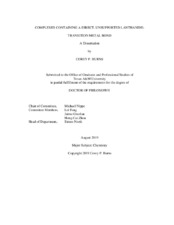| dc.description.abstract | The synthesis and characterization of molecules containing a direct, unsupported lanthanide transition metal bond is an ambitious task. Adding to this challenge, it is difficult to design a system in which both the lanthanide and transition metal can be interchanged to assess the nature of this interaction. As metal-metal bonding has provided significant insights into chemical bonding, catalysis, and electronic structure, it is important to pursue this rarely reported interaction. Additionally, lanthanide-transition metal heterometallics have drawn recent interest in the field of single-molecule magnetism (SMMs).
Initially, dinuclear lanthanide complexes containing bridging chloride (Cl¯) or triflate (OCF3SO2 - ) ligands were isolated as synthons for future reactions. These complexes were successfully prepared by reacting a dysprosium salt with the previously reported 2,6- bis(methylenecyclopentadienyl)pyridine disodium salt Nav2PyCp2 (PyCpv2 = 2,6- (CHv2Cv5H3)2C5Hv3N]^2- ) to yield [(PyCpv2)Dy(μ-OTf)]v2 and [(PyCp2)Dy(μ-Cl)]2. Of note, this was the first structurally characterized organometallic dysprosium triflate complex. These complexes exhibited properties of an SMM as evidenced by static and dynamic magnetic measurements. Despite the identity of the bridging ligand differing in the compounds, both exhibited a similar energy barrier (U) to reorient spin.
As dysprosium garners substantial attention in the field of SMMs, complexes containing a Dy-TM were first targeted. The reaction between [(PyCpv2)Dy(μ-OTf)]v2 and anionic transition metal fragments KFp or KRp (Fp = [CpFe(CO)v2] - , Rp = [CpRu(CO)v2]), afforded the complexes PyCpv2Dy-FeCp(CO)v2 and PyCp2Dy-RuCp(CO)v2. Infrared and Mössbauer spectroscopic studies suggested this interaction to be strong TM→Dy bonding interactions which is further supported by computational analysis.
Magnetization dynamics performed in this study determined both compounds exhibited field induced slow magnetic relaxation with similar barriers despite different relaxation times. A later study compared the spectroscopic and magnetic properties of (thf)PyCpv2Ce-FeCp(CO)v2 to that of PyCpv2Dy-FeCp(CO)2 and concluded that the identity of the lanthanide has an influence on the magnetic properties of these heterobimetallic systems. Spectroscopic and computational analysis demonstrated weaker TM→Ln interactions in the (thf)PyCp2CeFeCp(CO)2 as compared to PyCp2Dy-FeCp(CO)v2. Preliminary findings on other Ln-TM bonded complexes isolated with this ligand system will be shared. | en |


